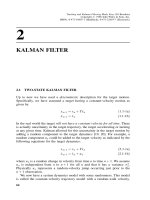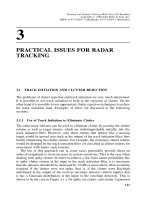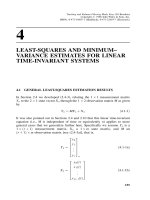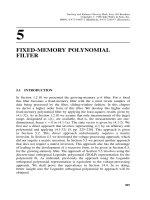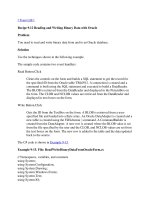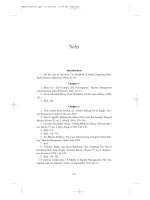Tài liệu Tracking and Kalman filtering made easy P3 pdf
Bạn đang xem bản rút gọn của tài liệu. Xem và tải ngay bản đầy đủ của tài liệu tại đây (374.36 KB, 41 trang )
3
PRACTICAL ISSUES FOR RADAR
TRACKING
3.1 TRACK INITIATION AND CLUTTER REJECTION
The problems of clutter rejection and track initiation are very much interwined.
It is possible to use track initiation to help in the rejection of clutter. On the
other hand it is possible to use appropriate clutter rejection techniques to reduce
the track initiation load. Examples of these are discussed in the following
sections.
3.1.1 Use of Track Initiation to Eliminate Clutter
The radar track initiator can be used to eliminate clutter by passing the clutter
returns as well as target returns, which are indistinguishable initially, into the
track initiation filter. However, only those returns that behave like a moving
target would be passed into track at the output of the track initiation filter, thus
finally eliminating the clutter returns. For example, the stationary clutter returns
would be dropped by the track initiation filter (or classified as clutter returns for
association with future such returns).
The use of this approach can in some cases potentially provide about an
order of magnitude or more increase in system sensitivity. This is the case when
dealing with spiky clutter. In order to achieve a low false-alarm probability due
to spiky clutter returns at the input to the track initiation filter, it is necessary
that the detector threshold be increased by 10 dB or more above what would be
required if the clutter were not spiky, that is, if the clutter were Rayleigh
distributed at the output of the receiver envelope detector (which implies that
it has a Gaussian distribution at the input to the envelope detector). This is
shown to be the case in Figure 3.1-1 for spiky sea clutter, rain clutter, lognormal
111
Tracking and Kalman Filtering Made Easy. Eli Brookner
Copyright # 1998 John Wiley & Sons, Inc.
ISBNs: 0-471-18407-1 (Hardback); 0-471-22419-7 (Electronic)
clutter, and Weibull clutter for low probabilities of false alarm of 10
À6
.For
mountain land clutter the situation is even worse. Here the threshold has to be
increased 20 dB for a 20-dB worse sensitivity than for Rayleigh clutter when a
low probability of false alarm of 10
À5
is desired. Extrapolating the curve of
Figure 3.1-1 indicates that if a higher false-alarm probability of 3 Â 10
À3
is
used, then there is essentially no loss of sensitivity for spiky sea and rain clutter
and a low loss for lognormal clutter and Weibull clutter. The idea is to use a
higher false-alarm probability for detection and to then use the track initiator to
eliminate the false alarms resulting from the spiky clutter.
The APL retrospective detection is an example of such a system. It uses the
track initiator to eliminate spiky sea clutter for an ocean surveillance radar
Figure 3.1-1 Typical measured and theoretical clutter probability distributions. (After
Prengaman, et al., ‘‘A Retrospective Detection Algorithm for Extraction of Weak
Targets in Clutter and Interference Environments,’’ IEE 1982 International Radar
Conference, London, 1982.)
112
PRACTICAL ISSUES FOR RADAR TRACKING
without penalizing system sensitivity [32, 33]. In fact system sensitivity is
increased because scan-to-scan video integration is used. For the retrospective
detector the returns from eight successive scans are examined to determine if
they form a moving-target track. If they do, a target is declared present. If they
do not, then it is assumed that only clutter was observed. (As we shall see
shortly, the retrospective detector even permits the detection of stationary
targets, such as buoys, and zero Doppler targets.) The details of the procedure
now follows.
The radar coverage is broken down into small range and bearing regions. For
each of these regions the returns from eight scan are stored. By way of
illustration, Figure 3.1-2 plots an example set of such returns seen as range
versus bearing and time. These are the returns from one of the range–bearing
regions mentioned. It is next determined if any set of these returns correspond
to a target having a constant velocity. Return numbers 1, 4, 6, 10, 12, and 14
form the returns from such a constant-velocity target, the target having a
velocity in the band between 28 and 35 knots. The rule used for declaring a
target present in a Doppler band is that M out of N returns be detected in the
band. Here N ¼ 8 and typically M would be of the order of 5.
The retrospective detector was implemented by APL on the AN/FPS-114
radar mounted on Laguna Peak on the California coast. This S-band radar has a
range resolution of 50 ft and azimuth beamwidth of 0.9
. Its scan period is 4 sec
with no coherent Doppler processing being used. Figure 3.1-3 shows the raw
data observed in the lower southwest quadrant after constant false-alarm rate
(CFAR) processing. The returns from 100 scans are displayed in the figure. The
coverage is out to a range of 9 nmi. A digital range-averaging logarithmic
CFAR was used by the system for the results shown in Figure 3.1-3. The results
shown in Figure 3.1-3 were obtained without the use of the retrospective
detector. A high false-alarm rate, about 10
À3
, was used in obtaining the results
of Figure 3.1-3. This resulted in about 2000 false alarms per scan. In this figure
the sea clutter false alarms are indistinguishable from small target returns
resulting from a single scan. Figure 3.1-4 shows the results obtained after
retrospective detector processing; again 100 scans of data are displayed. The
retrospective detector has reduced the false-alarm rate by at least four orders of
magnitude. The ships and boats in the channel are clearly visible. The reduction
in the false-alarm rate provided by the retrospective detector is further
demonstrated in Figure 3.1-5, which displays 1000 scans of data (about 1 h of
data). Very few false alarms are displayed.
The echo from a clutter spike generally will not generated a false-alarm
return at the output of the retrospective detector. this is because a spiky echo
return typically does not have a duration of more than about 10 sec [34–36]. If it
did, a retrospective detector with a longer integration time and higher threshold
M would be used. As mentioned, the detector even allows the detection of
targets having a zero Doppler velocity. Such returns could arise from ships
moving perpendicularly to the radar line of sight and from buoys. The detection
of buoys is essential for shipboard radars navigating shallow waters.
TRACK INITIATION AND CLUTTER REJECTION
113
114
PRACTICAL ISSUES FOR RADAR TRACKING
The above data showed the effectiveness of the retrospective detector in
detection of targets in an ocean clutter. This type of detector would also be very
effective in detecting targets over spiky land clutter, potentially reducing or
eliminating the large detection sensitivity loss otherwise needed to eliminate
spiky clutter.
The hardware implementation of the above retrospective detector for the
AN/FPS-114 radar consisted of 6 Â 6-in. wire wrap cards containing 250 small
and medium-scale integrated circuits (late 1970s/early 1980s technology). The
total power consumption is 30 W. This implementation is limited to 2000
contacts per scan by the memory size available. With the use of modern very
large scale integrated (VLSI) circuitry, the size of the signal processor will
decrease and its capability increase. Table 3.1-1 summarizes the characteristics
of the retrospective detector and its performance.
3
Figure 3.1-2 Operation of retrospective processor: (a) returns from single scan; (b)
returns from Eight Scans; (c) eight scans of data with trajectory filters applied. (After
Prengaman, et al., ‘‘A Retrospective Detection Algornithm for Extraction of Weak
Targets in Clutter and Interference Environments,’’ IEE 1982 International Radar
Conference, London, 1982.)
Figure 3.1-3 Raw data observed in lower southwest quadrant after CFAR processing
(100 scans of data; 9 nmi total range). (After Prengaman, et al., ‘‘A Retrospective
Detection Algorithm for Extraction of Weak Targets in Clutter and Interference
Environments,’’ IEE 1982 International Radar Conference, London, 1982.)
TRACK INITIATION AND CLUTTER REJECTION
115
3.1.2 Clutter Rejection and Observation-Merging Algorithms for
Reducing Track Initiation Load
In this section we shall describe how clutter rejection and observation-merging
algorithms are used to reduce the track initiation load for a coherent ground
two-dimensional surveillance radar. A two-dimensional radar typically is a
radar that has a vertically oriented narrow fan beam (see Figure 1.1-1) that is
Figure 3.1-4 Results obtained after retrospective detector processing using 100 scans
of data. (After Prengaman, et al., ‘‘A Retrospective Detection Algorithm for Extraction
of Weak Targets in Clutter and Interference Environments,’’ IEE 1982 International
Radar Conference, London, 1982.)
Figure 3.1-5 Retrospective detector output after 1000 scans of data (about 1 hr of
data). (After Prengaman, et al., ‘‘A Retrospective Detection Algorithm for Extraction of
Weak Targets in Clutter and Interference Environments,’’ IEE 1982 International Radar
Conference, London, 1982.)
116
PRACTICAL ISSUES FOR RADAR TRACKING
scanned 360
mechanically in azimuth about the local vertical axis [1]. Such a
radar provides two-dimensional information: slant range and the bearing angle
to the target. (These algorithms are also applicable to three-dimensional radars,
that is, radars that measure target range, azimuth, and elevation simultaneously
as done with the GE AN/FPS-117 [1, 37], the Marconi Martello stacked beam
radars [1, 38– 40], and the Westinghouse ARSR-4 [1].) The next four
paragraphs will describe how the Lincoln Laboratory moving-target detector
(MTD) Doppler suppression technique works [41, 42].
3.1.2.1 Moving-Target Detector
For a radar using the Lincoln Laboratory MTD clutter rejection technique, the
radar pulse repetition rate (PRF), that is, the rate at which the radar pulses are
transmitted measured in pulses per second, and antenna scan rate are chosen so
that the target is illuminated by more than 2N pulses on one scan across the
target. For the first N pulses PRF ¼ PRF
1
is used. For the second set of N pulses
PRF ¼ PRF
2
is used. The purpose of the two PRFs is to remove pulse-Doppler
ambiguities and blind velocities that result if only are PRF is used as shall be
explained shortly. Briefly the pulse Doppler velocity ambiguity and blind
velocities arise because typically the PRFs used are too low to permit
unambiguous pulse Doppler velocity measurements, that is, the PRF is lower
than the Nyquist sampling rate needed to measure the maximum Doppler shift
from the target unambiguously.
An MTD system is coherent, meaning the transmitted train of N pulses can
be thought of as generated by gating a stable radio frequency (RF) oscillator.
The system can be thought of as a sample data system where the sampling is
done on transmit. One could just as well have transmitted a continuous wave
(CW) and done the sampling on receive. However, range information would
then not be available. In order not to have range ambiguities, the pulse-to-pulse
period is made larger than the round-trip distance to the longest range target
TABLE 3.1-1. Retrospective Detector
Radar demonstrated on:
S-band AN/FPS-114 at Laguna Peak, CA
Resolution: 0.1 msec Â0:9
4-sec scan-to-scan period
1500 ft altitude
Retrospective processor: special purpose, consisting of six 6 Â 6-in. wire wrap cards
containing 250 small and medium integrated circuits; total power: 30 W
(Late–1970s/early–1980s technology.)
Performance results: with single-scan false-alarm rate set at 2000 per scan, after
100 scans false-alarm rate reduced by at least four orders of magnitude, after
1000 scans ($ 1 hr) only a few alarms visible
TRACK INITIATION AND CLUTTER REJECTION
117
from which echoes are expected. For example, if the maximum range for the
radar is 100 nmi, then the pulse-to-pulse period would be (100 nmi)
(12.355 nmi/msec) ¼ 1235 msec or greater. The system PRF would then be
1=1235 msec ¼ 810 Hz. For a 1.3-GHz carrier frequency L-band radar an
approaching target having a Doppler velocity of 182 knots would give rise to a
Doppler-shifted echo having a Doppler shift equal to the PRF of 810 Hz.
Because we have in effect a sampled data system with a sample data rate of
810 Hz, any target having a target velocity producing a Doppler shift higher
than the sampling rate would be ambiguous with a target having a Doppler shift
lower than the sampling rate. For example, a target having a Doppler velocity of
202 knots would appear as a Doppler-shifted signal produced by a target having
a Doppler velocity of 202 knots modulo the sampling rate of 182 knots, or
equivalent 20 knots. Thus we would not know if the target actually was going at
202 knots or 20 knots, hence the ambiguity. The use of the second PRF for the
second set of N pulses removes this ambiguity problem. This is done by the
application of the Chinese remainder theorem.
A blind velocity problem also arises from the Doppler ambiguity problem. If
the target had a Doppler velocity of 182 knots, that is, equal to the sampling
rate, then it would be ambiguous with the zero Doppler echo returns. But the
zero Doppler returns are primarily from strong ground clutter. Hence, the echo
from a 182-knot target is ambiguous with the strong ground clutter. As a result,
often if would be most likely masked by the ground clutter return. This results
in the second reason for use of the second set of N pulses at a second PRF. A
target ambiguous in Doppler with the zero Doppler clutter on the first PRF will
not be ambiguous on the second PRF. This same problem occurs for near zero
Doppler rain clutter and a Doppler ambiguous aircraft echo. The rain could
mask the ambiguous aircraft echo. This masking also is eliminated by the
second set of N pulses having the second PRF.
A typical value for N is 8. To measure the Doppler velocity of the target in a
given range cell, the N ¼ 8 echoes from this range cell are passed into a bank of
N ¼ 8 narrow Doppler filters covering the band from 0 to 182 knots, with each
filter having a bandwidth of (182 knots)/8 ¼ 22.8 knots. The nonzero Doppler
filters would have a frequency transfer characteristic with a notch at zero
Doppler frequency so as to better reject the zero Doppler ground clutter while at
the same time passing the signal in the Doppler band of that filter. One would
think that the output of the zero Doppler filter is ignored, having the strong
ground clutter return. Actually it is not ignored. Instead the filter centered at
zero Doppler is used to detect aircraft targets moving perpendicularly to the
radar line of sight, which as a result have a zero Doppler velocity. Such targets
can often be detected in the clutter because when the target has a zero Doppler
velocity it is being viewed broadside. For this aspect angle the target generally
has a very large cross section. Hence it is possible that its return echo will be
stronger than that of the ground clutter. When this occurs, the target is detected.
To prevent the detection of ground clutter echoes in the zero Doppler filter, the
threshold in this filter is set higher than the ground clutter. The setting of this
118
PRACTICAL ISSUES FOR RADAR TRACKING
threshold varies with range and azimuth since the clutter strength varies with
range and azimuth. To determine what value the threshold should be set at for a
given range–azimuth cell, a clutter map is generated. For this clutter map the
strength of the clutter for each range–azimuth cell of the radar is stored in
memory. Typically the power of the echo in a particular range–azimuth cell
from the last H scans (where H might be of the order of 7 to 10) are averaged to
generate the clutter strength for this cell. An exponentially decaying average is
typically used for ease of implementation, it then being possible to implement
the filter with a simple feedback infinite-impulse response filter rather than the
more complicated finite-impulse response filter. The above described processor
is the Lincoln Laboratory MTD [41, 42].
Lincoln Laboratory first implemented an MTD for the FAA experimental
AN/FPS-18 air traffic control radar at the National Aviation Facilities
Engineering Center (NAFEC). It was installed in 1975. The FPS-18 is an
S-band (2.7 to 2.9 GHz) radar having a PRF of 1000 to 1200 Hz [41, 42, 44].
For this radar, in effect, N ¼ 8, with eight Doppler filters used to process eight
echo pulses. The coherent processing of a set of N ¼ 8 echoes having a
specified PRF is called a coherent procesing interval (CPI). There are thus eight
Doppler outputs per range cell per CPI. Figure 3.1-6 shows a typical system
Figure 3.1-6 Typical ASR single-scan return from single target. Radar range
resolution was
1
16
nmi while Doppler resolution was about 16 knots. (From Castella,
F. R. and J. T. Miller, Jr., ‘‘Moving Target Detector Data Utilization Study,’’ IEE
Radar—77, London, 1977.)
TRACK INITIATION AND CLUTTER REJECTION
119
return for a single target resulting from a single scan across the target with a
two-dimensional TWS radar. Each dot represents a Doppler filter crossing. For
the first range cell return from the target there are four CPIs observed for the
target. For the next range cell three CPI detections are observed for the same
target. For each CPI the target is also detected in more than one Doppler cell. In
some cases all eight Doppler cells show detections. Apparently a low detection
threshold was used for the illustrated scan given.
3.1.2.2 Observation Merging (Redundancy-Elimination, Clustering)
Castella and Miller [44] noticed that in general, for a single scan across a target,
detection occurred for more than one range–Doppler–azimuth cell. It is
imperative that all these detections from the same targets not be reported as
separate target returns as this would lead to an overload of the tracker. The
association of such detections, called redundant detections, with a single target
and reporting them as a single range–Doppler–bearing report for one target is
called observation merging [8], redundancy elimination [8], and clustering [16].
Techniques to be used for observation merging are discussed in detail in
reference 8.
Redundant detections, while being a problem, can be used to effectively
eliminate false clutter returns. Very effective algorithms developed by Castella
and Miller (of the Johns Hopkins University APL) for doing this are described
in reference 44. These are now summarized.
Castella and Miller found that aircraft targets on which there is a firm track
typically give rise to responses in two or more of either range cells, Doppler
cells, or azimuth cells during one pass across the target. Clutter returns on the
other hand typically give rise to only one range, Doppler, or azimuth cell
response. As a result they suggested the use of this characteristic to eliminate
clutter returns before they have passed onto the track initiator. Table 3.1-2
shows the statistics for single range, Doppler, and bearing CPI returns for
aircraft targets for which there is a firm track and for cell echoes which are
primarily comprised of clutter returns. About 79% of the clutter echoes consist
of only one range cell response, one Doppler cell response, or one bearing cell
response. In contrast, for aircraft targets for which there is a firm track, only 15
TABLE 3.1-2. Sample Centroid Statistics
Percent of Percent of
Characteristics All Centroids Firm Track Centroids Only
Number of CPIs ¼ 1 78.7 15.2
Maximum number of Doppler cell 78.7 13.7
detections per CPI per range cell ¼ 1
Maximum range extent ¼ 1 79.3 21.0
Total centroids considered 34,445.0 3485.0
Source: After Castella and Miller [44].
120
PRACTICAL ISSUES FOR RADAR TRACKING
to 21% of the echoes will consist of only one range cell response, one Doppler
cell response, or one bearing response. Figure 3.1-7 shows how effectively
clutter returns can be eliminated by using an algorithm that requires two or
more bearing returns (that is, CPI returns) for the target to be declared detected.
Figure 3.1-7a shows all the target detections obtained in a 50-sec interval if a
target detection is based on the observation of one CPI return. Figure 3.1-7b
shows the radar target detections if it is required that two or more CPIs be
observed. More than 75% of the original centroids have been eliminated using
this simple algorithm. Yet the number of target tracks is seen to be virtually
identical for both displays.
Figure 3.1-8 shows the benefits accrued from using the following two
constraints for declaring a target detection: (a) detection on two or more CPIs
and (b) detection on two or more Doppler cells per range–bearing cell. Figure
3.1-8a gives the resulting detections of 335 scans when no constraints are used
for declaring a detection; that is, detection is based on observing one or more
range–Doppler CPI detections. For this case 54 tracks were observed. Figure
3.1-8b gives the results when the above two constraints were used. The number
of tracks observed was reduced from 54 to 44. However, the mean track
duration increased from 39.1 to 47.6 sec. Reference 44 concludes from results
like these that only insignificant short-term clutter tracks are being eliminated.
More significantly, the number of tentative tracks were reduced from 14,000 to
a little over 800, a 17:1 reduction in the track load. Table 3.1-3 summarizes the
results obtained with the above two constraints.
3.1.3 Editing for Inconsistencies
Sometimes the clutter returns will overlap the signal returns and corrupt the
range, Doppler, and bearing estimations for the target. It is desirable to know
when the data are corrupted. Corrupted data could then be appropriately treated
in the track update filter, either by not using it or by giving it a low weighting
for determining the next update position. The presence of such corruption can
be determined by looking for inconsistencies in the data [44]. For example, the
presence of inconsistencies in the Doppler between adjacent range cells would
be indicative of possible corruption from clutter. Another possible reason for
this inconsistency could be that two targets are overlapping. In either case
noticing such inconsistencies alerts one to the fact that the Doppler estimate is
being corrupted. Similarly, inconsistencies in the Doppler for successive CPIs
would be indicative of possible clutter corruption. Finally inconsistencies
between the amplitudes of the return between successive CPIs in one scan
would also be indicative of possible clutter corruption.
3.1.4 Combined Clutter Suppression and Track Initiation
It is apparent from Sections 3.1.1 and 3.1.2 that clutter suppression and track
initiation go hand in hand. Often the engineer generating the clutter supression
TRACK INITIATION AND CLUTTER REJECTION
121
algorithms works independently of the engineer generating the track initiation
algorithms. The two must work hand in hand to achieve best results. The
literature is rich in clutter rejection techniques, and it is the designers task to
pick those most applicable to a situation; for example, see References 16, 27,
29, 32, 33, 41, 42, 44 to 61, and 135.
The clutter suppression and track initiation algorithms act as filters for
reducing the number of false tracks. Figure 3.1-9 illustrates this for a system
designed by APL [56]. This system applies various algorithms for suppressing
real-world clutter for a two-dimensional shipboard surveillance radar. For this
system there are 6 Â 10
6
samples per scan. These samples are filtered down to
just 392 initial contacts. After further screening these in turn are filtered down
Figure 3.1-7 (a) Target detections obtained in 50-sec interval when target detections
are based on observation of only one CPI return. (b) Target detections when two or more
CPIs are required for declaring its presence. (From Castella, F. R. and J. T. Miller, Jr.,
‘‘Moving Target Detector Data Utilization Study,’’ IEE Radar—77, London, 1977.)
122
PRACTICAL ISSUES FOR RADAR TRACKING
to 35 possible track updates and 6 tentative tracks. On the average, for the
system under consideration only 1 out of 15 of the tentative tracks becomes a
firm track after further processing. The 35 possible track updates are filtered
down to just 21 firm track updates.
Feedback can be used at various stages of a well-designed system in order to
reduce the number of false tracks and enhanced the target detectability. The
enhancement of target detectability is achieved by lowering the threshold in
prediction windows where the track updates are expected to appear. This proce-
dure is referred to as ‘‘coached’’ detection; see reference 8.
Feedback for controlling the threshold over large areas of coverage have
been used in order to lower the false-alarm rate per scan [16]. This is called area
Figure 3.1-7 (Continued)
TRACK INITIATION AND CLUTTER REJECTION
123
CFAR control. It was used in the Lincoln Laboratory ATC experinental ASR-7
MTD processor to eliminate heavy angel clutter (birds, insects, etc.); see
Figure 3.2-10. Figure 3.1-10a shows the radar display without the use of the
feedback adaptive thresholding, that is, without area CFAR. Illustrated is a
situation of heavy angel clutter. Figure 3.1-10b shows the same display with the
area CFAR being used.
Two types of feedback were used in above Lincoln Laboratory system. The
first, fast feedback having a time constant of about 5 sec, was applied to control
the threshold in an area consisting of all ranges less than 20 nmi. The data from
three Doppler bins were used. Its purpose was to respond quickly to the onset of
Figure 3.1-8 (a) Detections observed after 335 scans when target detection is based on
observation of one or more range–Doppler CPIs. (b) Detections observed when two
constraints are imposed: That two or more CPIs be detected and that detections on two
or more Doppler cells per range–bearing cell be observed. Number of target tracks
reduced from 54 to 44. Mean target track duration increased from 39.1 to 47.6 sec.
Number of tentative tracks reduced from 14,000 to 800 —17 : 1 track load reduction.
(From Castella, F. R. and J. T. Miller, Jr., ‘‘Moving Target Detector Data Utilization
Study,’’ IEE Radar—77, London, 1977.)
124
PRACTICAL ISSUES FOR RADAR TRACKING
Figure 3.1-8 (Continued)
TABLE 3.1-3. FPS-18 MTD System Results
Clutter removal algorithm
Require detection on ! 2 CPIs
Require detection on ! 2 Doppler cells per range–azimuth cell
Results
Number of firm tracks decreased from 54 to 44 in 335-scan run
Number of tentative tracks during entire run reduced from 14, 000 to 800 — a
17:1 track load reduction
Source: From Castella and Miller [44].
TRACK INITIATION AND CLUTTER REJECTION
125
Figure 3.1-9 Joint action of clutter suppression and track initiation as filters for
reducing number of false alarms due to severe clutter and radio frequency interference
(RFI). (From Bath et al., ‘‘False Alarm Control in Automated Radar Surveillance
Systems,’’ IEE 1982 International Radar Conference, Radar—82, London, 1982.)
Figure 3.1-10 Improvement provided by feedback area CFAR processing: (a) radar
display without area CFAR; (b) display with area CFAR. (From Anderson, J. R. and
D. Karp, ‘‘Evaluation of the MTD in a High-Clutter Environment,’’ Proceedings of IEE
International Radar Conference, # 1980 IEEE.)
126
PRACTICAL ISSUES FOR RADAR TRACKING




